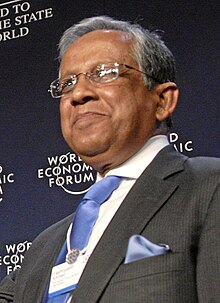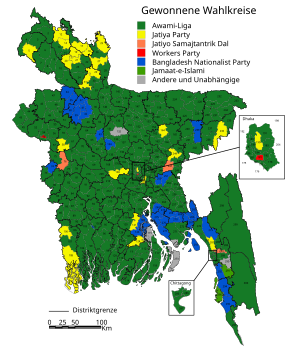General election in Bangladesh in 2008
The parliamentary election in Bangladesh in 2008 was the 9th parliamentary election since Bangladesh gained independence and took place on December 29, 2008. According to the schedule, the election should have taken place two years earlier. After the government was accused by the opposition parties of attempting to manipulate the election results, violent clashes broke out and the election date was canceled. A state of emergency was declared and an interim government supported by the armed forces took over the government for two years. In the election, the Awami League , which had previously been in opposition, won a two-thirds majority of parliamentary seats. After the election, the party leader of the Awami League, Hasina Wajed , was sworn in as the new Prime Minister on January 6, 2009. She had held this office from 1996 to 2001. The election was monitored by numerous national and international election observers and was orderly and largely peaceful.
prehistory
The previous election in 2001 was won by the Bangladesh Nationalist Party (BNP) in an electoral alliance with the Islamist Jamaat-e-Islami and other smaller parties. The leader of the BNP, Khaleda Zia , subsequently became prime minister of a coalition government. International election observers judged the 2001 election to be sufficiently free, fair and non-violent. Due to the polarized party landscape in Bangladesh, which is also strongly characterized by personal enmities between party leaders, the defeated Awami League took a stance of total opposition, questioned the legitimacy of the election and refused to engage in constructive political dialogue for almost the entire legislative period with the government.
In October 2005, three months before the planned election date, the Zia-led government resigned and handed over the business of government to a caretaker government . This has been prescribed by the Bangladeshi constitution since 1996, with the purpose of preventing election manipulation by the incumbent government. According to the original constitutional regulation of 1996, the President of Bangladesh should have appointed the last presiding judge of the Bangladesh Supreme Court, who retired for reasons of age, as the acting head of government of the trustee government. The BNP government changed this constitutional principle with its two-thirds majority in parliament in 2005 so that it raised the retirement age for judges from 65 to 67 years. The opposition suspected that with this step Judge KM Hasan , the preferred candidate of the BNP, should be maneuvered into the office of head of government. When President Iajuddin Ahmed Hasan offered the office of head of government to the trustee government to be established in October 2005, violent protests by the opposition broke out, killing more than 25 people. Hasan then voluntarily resigned from the office. After Hasan's resignation, according to the constitution, the state president should have asked other specified officials to take office. However, this did not take place and on October 31, 2005 President Ahmed himself stood up as head of government of the trustee government, a measure which, according to the constitution, was actually only intended as a last resort.
For the Awami League and its allies, Ahmed, who was elected by the BNP government in 2002, was even less impartial than Hasan. On January 3, 2007, the Awami League openly called for an election boycott and called for the election date to be postponed. Massive acts of violence between supporters of the government and the opposition were to be feared. Under pressure from the Bangladeshi military leadership, President Iajuddin Ahmed declared a state of emergency on January 11, 2009 , proclaimed a postponement of the election date and at the same time declared his resignation as chairman of the trustee government. His successor as head of government in the Trustees' government was the widely respected former director of the Central Bank of Bangladesh , Fakhruddin Ahmed , who enjoyed the support of the military. From abroad, the events were sometimes viewed as a "covert military coup ". The new government initially banned mass political events and regulated the press and radio. It announced an ambitious program of political reforms, which were primarily directed against rampant corruption. Various institutions such as the Election Commission, the Anti-Corruption Commission and the Commission for the Public Service were re-established or reformed. In 2007, numerous politicians, including the leaders of the two major political parties, BNP and Awami-Liga, Zia and Hasina, were charged with corruption and imprisoned for several months.

The policy of the transitional government initially enjoyed great support from the Bangladeshi public. However, most of the anti-corruption investigations fizzled out and many detained defendants were released without trial. From autumn 2008 the government began to prepare for a new parliamentary election. Particularly important in the election was the Bangladeshi election commission, whose work and extensive impartiality were praised by almost all sides and seen as a step forward compared to previous elections. The electoral rolls were created in digital form for the first time in the country's history. The election itself was monitored by 60 international election observers from the National Democratic Institute for International Affairs and more than 181,000 local election observers on site. According to unanimous statements, the pre-election period and the actual election were remarkably peaceful and orderly.
Electoral system
The Parliament of Bangladesh had 345 members. 300 MPs were elected using simple majority voting in as many one-person constituencies. Shortly before the current election, the constituencies were redistributed in accordance with the changed population situation. Forty-five additional seats were reserved for women, who are elected by the elected representatives according to the parties' share of the votes.
Results
81,058,698 registered voters were entitled to vote. 32 registered political parties competed in the election and the election took place in 35,216 polling stations. The official election results were announced on January 1, 2009 by the Bangladesh Election Commission . On January 12, 2009, the postponed election in the Noakhali-1 constituency, won by the BNP candidate, was rescheduled. According to official figures, voter turnout was 87% and thus significantly higher than in the previous election. Foreign observers and the population described the election process as orderly, peaceful and regular.
Nationwide result
| alliance | Political party | be right | % | Seats | +/- | |
|---|---|---|---|---|---|---|
| Great alliance | Awami League | 33,887,451 | 49.0% | 230 | +168 | |
| Jatiya party | 4,867,377 | 7.0% | 27 | +16 | ||
| Jatiya Samajtantrik Dal | 429.773 | 0.6% | 3 | +2 | ||
| Workers Party of Bangladesh | 214,440 | 0.3% | 2 | +1 | ||
| Liberal Democratic Party | 161,372 | 0.2% | 1 | ± 0 | ||
| Four-party alliance | Bangladesh Nationalist Party | 22,963,836 | 33.2% | 30th | −163 | |
| Jamaat-e-Islami | 3,186,384 | 4.6% | 2 | −15 | ||
| Bangladesh Jatiya Party-BJP | 95,158 | 0.1% | 1 | −4 | ||
| Islami Oikya Jote | - | - | - | - | ||
| Independent and others | 3,366,858 | 4.9% | 4th | −2 | ||
| total | 69.172.649 | 99.99% | 300 | - | ||
| Source: Election Commission website Report of the International Observer Mission | ||||||
The option “no vote” could also be ticked on the ballot papers. This was intended as an option for voters to express their dissatisfaction with all candidates standing for election without casting a blank ballot. However, only 382,437 voters (0.55%) made use of this option.
Won constituencies by division
The Awami League won a majority of the constituencies in each of Bangladesh's 6 divisions . She achieved the clearest result in the Dhaka division, the closest results in the Chittagong and Rajshahi divisions.
| division | Awami League | BNP | Jatiya party | JSD | Jamaat | BWP | BJP | LDP | Independent | Total seats |
|---|---|---|---|---|---|---|---|---|---|---|
| Barishal | 16 | 2 | 2 | 0 | 0 | 0 | 1 | 0 | 0 | 21st |
| Chittagong | 32 | 18th | 2 | 2 | 2 | 0 | 0 | 1 | 1 | 58 |
| Dhaka | 87 | 0 | 5 | 0 | 0 | 1 | 0 | 0 | 1 | 94 |
| Rajshahi | 48 | 8th | 14th | 0 | 0 | 1 | 0 | 0 | 1 | 72 |
| Khulna | 30th | 2 | 2 | 1 | 0 | 0 | 0 | 0 | 1 | 36 |
| Sylhet | 17th | 0 | 2 | 0 | 0 | 0 | 0 | 0 | 0 | 19th |
| total | 230 | 30th | 27 | 3 | 2 | 2 | 1 | 1 | 4th | 300 |
Constituency map
Indirect election of 45 female MPs
On March 19, 2009, the Bangladeshi electoral commission announced the names of the 45 female MPs who had been nominated by the parties according to their proportional representation in parliament. The 45 seats were distributed as follows: Awami League 36, Bangladesh Nationalist Party 5, Jatiya Party 4. On March 29, 2008, the 45 female MPs were sworn in.
evaluation
The elections were remarkably orderly and non-violent. The voter turnout was very high at 87% by Bangladeshi standards. Benefiting from the current relative majority voting system, the Awami League won 230 (76.7%) from 300 constituencies and parliamentary seats with 49.0% of the votes. Together with the parties allied with it, it had a 4/5 majority in the new parliament. After the results were announced, Khaleda Zia, the party leader of the loser BNP, declared the election to be "manipulated" and rejected the election result. On January 6, 2009, the leader of the Awami League, Hasina Wajed, was elected as the new Prime Minister of Bangladesh . Two days later, Khaleda Zia and the other elected parliamentarians of the BNP also took the MP's oath. On behalf of the BNP, Salahuddin Quader Chowdhury declared that the BNP MPs would take part in the parliamentary sessions of the first parliamentary session “for the sake of democracy, in the interests of the country and in order to continue the democratic process”.
Web links
- Carmen Brandt: Elections in Bangladesh set new democratic standards on www.suedasien.info (January 29, 2009)
- International Observation Mission 2008/2009 Bangladesh Elections: Final Report (English)
Individual evidence
- ↑ a b c d e f g International Observation Mission 2008/2009 Bangladesh Elections: Final Report. (PDF) June 2009, accessed on January 29, 2016 (English).
- ^ Roland Buerk: Back from the brink in Bangladesh. BBC News, October 31, 2006, accessed January 30, 2016 .
- ↑ Bangladesh: The coup that dare not speak its name. The Economist, January 18, 2007, accessed January 30, 2016 .
- ^ New Bangladesh corruption charges. BBC News, September 26, 2007, accessed January 30, 2016 .
- ↑ John Sudworth: Bangladesh detentions extended. BBC News, March 6, 2007, accessed January 30, 2016 .
- ↑ Bangladesh parties reopen offices. BBC News, September 11, 2007, accessed January 30, 2016 .
- ↑ 45 Women Members of Parliament Sworn in. (PDF) Vibrant Bangladesh Volume 2, Issue 3, March 2009, accessed on February 7, 2016 (English).
- ↑ Khaleda Zia rejects 'rigged' poll. BBC News, December 30, 2008, accessed January 30, 2016 .
- ↑ Bangladesh Nationalist Party leaders to take oath, attend Parliament. zeenews.india.com, January 8, 2009, accessed January 30, 2016 .


